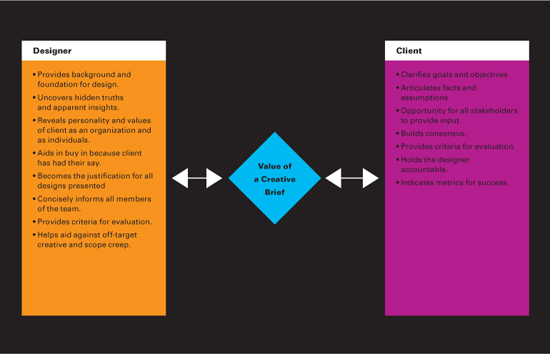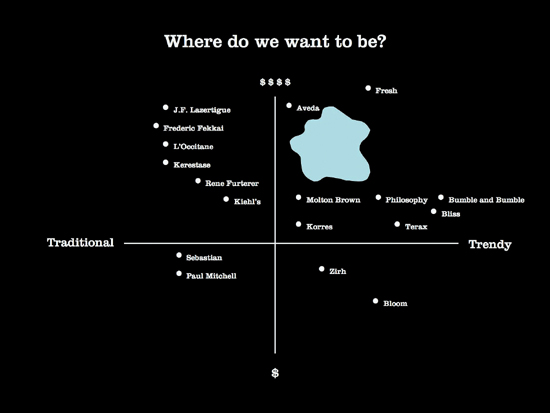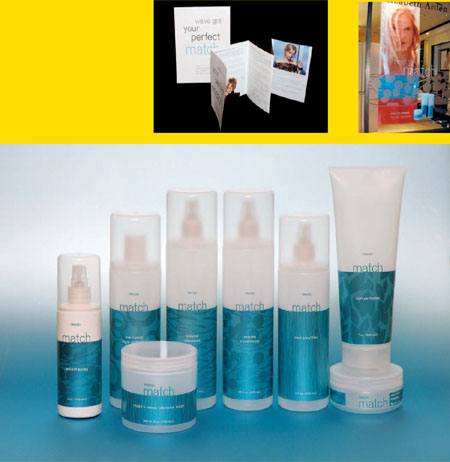Chapter 6
Creative Briefs

Creative Briefs Are Strategic Tools
Computer scientists have a saying, “Garbage in, garbage out.” It means that computers can process a lot of data output, but it will only be as good as the information that was put into the system. It’s pretty much the same in design. When creative is developed from great client input, the results can be great. If not, well, it’s a recipe for falling short of the mark. Without a well-identified and articulated set of objectives and goals that is rooted in thorough background and research information, a design can’t grow out of a solid foundation. There needs to be a summary of all the factors that can impact a design project. It is well worth the time it takes to develop it.
What’s in a Creative Brief?
In the best cases, a creative brief is created through meetings, interviews, readings, and discussions between a client and designer. It should contain background information, target audience details, information on competitors, short- and long-term goals, and specific project details. A creative brief will answer these questions:
• What is this project?
• Who is it for?
• Why are we doing it?
• What needs to be done? By whom? By when?
• Where and how will it be used?
Without making a framework for the project, the designer won’t be able to understand the parameters or context that needs to be worked within. The creative brief provides an objective strategic tool that can be agreed and acted upon. It can serve as a set of metrics by which to judge and evaluate the appropriateness of a design. At the very least, all the relevant project information is contained within a single document that can be shared as guidelines for the entire client and designer project team.
Negative Impact of No Creative Brief
Any designer who simply launches into a design assignment without a proper briefing doesn’t have all the relevant facts and opinions to do a well-informed job. They are also asking for trouble as work progresses. Approvals come with buy in; buy in is so often a result of feeling included and asked for input. Sure, the odds are that they can design something interesting and eye-appealing based on their gut instincts, but these solutions are not grounded in solid understanding, and they are more easily dismissed by both clients and target audiences.
The 10 Most Important Things to Include in a Creative Brief
What’s Included in a Design Criteria
Overview:
• Who they are [the client? the audience?]
• What the problem is (they say)
• What the problem is (really)
Research/Analysis Summary:
• What are they doing?
• What are others doing?
Approach:
• What we are recommending be done
• Design overview (brief statement about what needs to be done)
Client Sign Off:
• Approval to proceed with design. This is a critical step, if ever needed later as evidence of client approval in the case of things turning sour in a project.
Who Uses a Creative Brief?
Both the client and the design team use the creative brief. Creating it helps a client crystallize the salient information, gather their thoughts, and research and identify goals and objectives. It provides an opportunity for all stakeholders to give input and have their say. It aids in client buy in of the resulting designs mostly because the client team has all provided input.
For the designer, the brief provides relevant information to alleviate guesswork. Who knows the client’s business better than the client? By gathering this information concisely in one document, the creative brief is a criteria for evaluation, outlining metrics that indicate success, and ultimately holding the designer accountable—unless of course, the designer can convince their client that the creative brief is wrong.

Going without a Creative Brief
There are times when a formal creative briefing session, followed by a typewritten and comprehensive creative brief may not be necessary. The two main reasons are
• The assignment is a continuation of a larger program that the designer has already been working on. It may have had a formal creative brief at the start of the working relationship and now, with a wealth of experience having worked on a previous design, a new creative brief may not be needed. In essence, it is a project that falls within a larger, earlier creative brief.
• The client trusts the designer implicitly. They have worked together over the course of many years or many projects and, thus, have developed a kind of telepathy from such a close working relationship. The designer intuitively understands the client, their product or service, their competition, and their customer extremely well. This allows the client to state their problem or goal and then give the designer carte blanche to design as they see fit.
Both of these conditions involve trust and an extensive working relationship. Beginning design without being properly briefed under other circumstances is usually a recipe for disaster. The designer has no objective criteria on which to have their work evaluated. Mostly, they have not received adequate information as preparation for their work in the first place.












